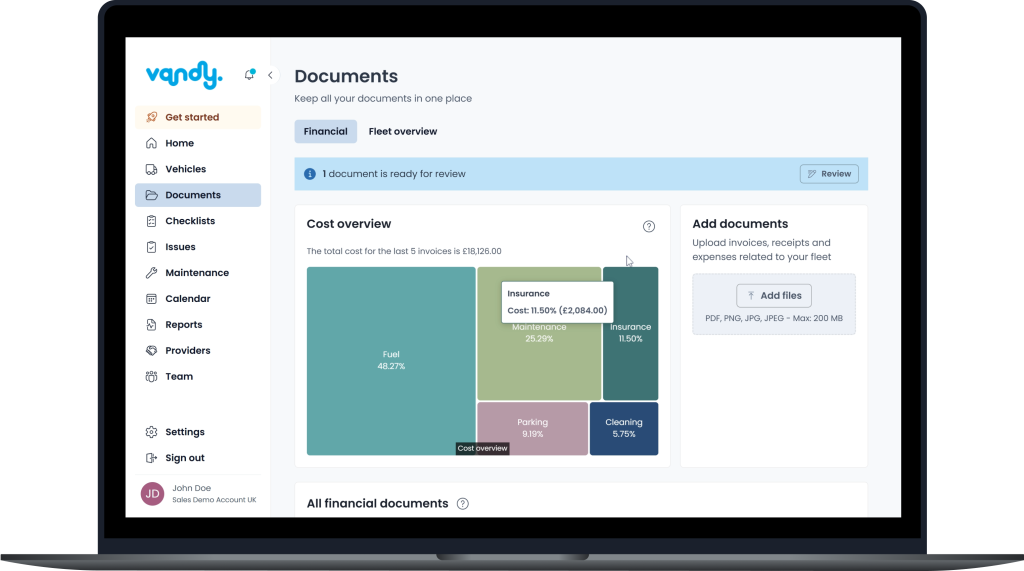How to calculate fleet Total Cost of Ownership

Ever wondered what your vehicles are really costing you? Running a fleet, big or small, comes with more costs than just buying vehicles and filling up the tank. Understanding your fleet Total Cost of Ownership (TCO) gives you a clear picture of what each vehicle truly costs and uncovers hidden expenses that can quietly add up. Done right, TCO gives you insights to make smarter decisions around maintenance, vehicle replacement, and how to get the most out of every vehicle.
In this article, you’ll learn:
- What is Total Cost of Ownership (TCO)?
- What are the primary components of TCO for fleets?
- How to calculate TCO for your fleet
- How Vandy helps reduce TCO and simplify fleet operations
- How to use TCO analysis to drive smarter financial decisions
What is fleet Total Cost of Ownership (TCO)?
TCO, or Total Cost of Ownership, is the total cost of owning and running a vehicle throughout its lifetime. It includes more than just the purchase price covering all ongoing and indirect expenses, so you get a clear picture of what your fleet really costs. By calculating TCO, you can analyze:
- How much each vehicle actually costs over time
- Which parts of your fleet are less efficient
- How to manage your vehicles more effectively and boost profitability
Understanding TCO is especially valuable as fuel prices, maintenance costs, and insurance premiums continue to rise.
What goes into calculating Total Cost of Ownership (TCO)
TCO includes both direct and indirect expenses across the lifespan of each vehicle. Here’s are the main cost categories:
- Vehicle acquisition – purchase price, registration fees, and taxes
- Fuel – often one of the biggest ongoing costs
- Maintenance and repairs – everything from routine servicing to unexpected fixes
- Insurance – basic liability, comprehensive coverage, and any additional policies
- Administrative and operating costs – tolls, parking, and management costs
- Depreciation – the loss of vehicle value over time
- Downtime costs – lost revenue or productivity when a vehicle is off the road
Fleet Total Cost of Ownership formula:
TCO = Acquisition + Fuel + Maintenance & repairs + Insurance + Admin & operating+ Depreciation + Downtime
Pro-tip
Breaking costs down by category and by vehicle gives you a clearer view of where money is going and helps you make smarter decisions about your fleet.
Why TCO analysis matters
Analysing your fleet’s TCO helps you:
- Spot unnecessary spending
- Plan your fleet budget more accurately
- Make smarter purchase and lease decisions
- Improve profitability
Looking only at the purchase price or fuel costs doesn’t tell the full story. Fleet TCO gives you a complete view of what each vehicle costs your business and helps you make smarter choices for your fleet.
How Vandy helps reduce fleet TCO
Vandy is a fleet management software designed to automate data collection and give you total visibility into costs. Here is how it helps you calculate, analyze, and reduce your fleet total cost of ownership:

- Centralized cost tracking
With Vandy, all your fleet expenses are stored in one place. You can easily see which costs belong to which vehicle, organise them into categories, and get reports that show how your vehicles compare. - AI-powered invoice reading
Just upload your invoices and receipts and Vandy’s AI will extract the key details for you, eliminating manual input. - Automatic mileage tracking
Vandy uses telematics to update vehicle mileage automatically, so there’s no need for manual logging. The accurate odometer data provides a solid foundation for fuel analysis, maintenance planning, and accurate lease mileage tracking.
→ What is telematics and how does it help? - Preventive maintenance schedules and alerts
Reactive repairs cost up to 4x more than preventive maintenance. Vandy helps you avoid surprise breakdowns by setting preventive maintenance schedules for each vehicle and sending reminders based on time or mileage. - Lease mileage tracking
Stay within your lease mileage limits. Vandy automatically monitors usage and alerts you before vehicles get too close to the limit, helping you avoid costly penalties at the end of the lease term. - Compliance reminders
Never miss a deadline again. Vandy automatically reminds you about insurance renewals, inspections, and other documents, so you can avoid fines and downtime.
→ What are the fines for missed vehicle inspections? - Track and categorize fuel spending
Monitor how much fuel your fleet is using and spot inefficiencies that may be driving up costs.
→ Learn how to calculate fuel consumption - Flag unauthorized vehicles use
Vandy automatically tracks your fleet’s trips and can alert you when vehicles are being used outside of business hours or for personal errands, helping you cut hidden costs.
Example: How TCO analysis lowers costs
Imagine you’re running a fleet of 10 vans. After tracking expenses in Vandy, you notice two vehicles are costing far more in maintenance than the rest. With that insight, you decide to retire one early and adjust the maintenance schedule for the other. Within a year, you’ve saved thousands on repair bills, avoided unexpected downtime, and freed up the budget for a newer, more reliable vehicle.
Summary: Turn TCO insights into real savings
TCO analysis isn’t just about tracking costs – it’s about knowing where your money goes and using that knowledge to make smarter decisions. With Vandy, you get the data and automation to:
- Cut unnecessary operational spending
- Replace or maintain vehicles at the right time
- Make smarter vehicle purchase and lease decisions
Start using Vandy today
See how fleet management software can help lower your fleet total cost of ownership
FAQ – Frequently Asked Questions
TCO stands for Total Cost of Ownership – the full cost of owning and running a vehicle over its lifetime. It includes direct expenses like purchase price, fuel, and insurance, as well as indirect costs such as depreciation, downtime, and admin fees.
Fleet total cost of ownership helps businesses understand the true cost of each vehicle, identify areas to cut costs, and make better decisions on maintenance, replacements, and budgeting.
Fleet total cost of ownership covers acquisition, fuel, maintenance and repairs, insurance, admin and operating costs, depreciation, and downtime costs.
Yes. Vandy helps collect invoices and receipts in digital form, and our AI reads and organises them so you can calculate and analyse your fleet total cost of ownership with less manual work. It also links costs to vehicles, tracks mileage, and generates reports automatically.
Fleet Total Cost of Ownership formula:Telematics automatically tracks mileage and vehicle usage. This data supports accurate fuel analysis, smarter maintenance planning, and lease management – cutting unnecessary costs.